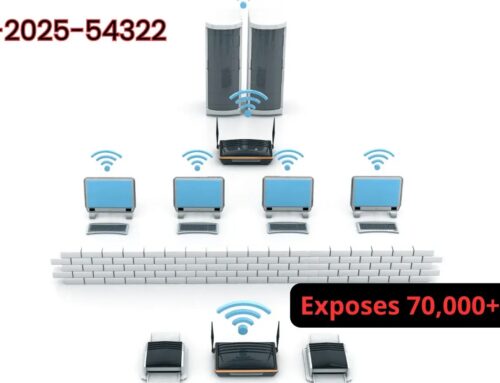
TP-Link Router 0-Day RCE Vulnerability Exploited Bypassing ASLR Protections – PoC Released
TP-Link Router Zero-Day RCE Exploit Bypasses ASLR: What You Need to Know
The security landscape for connected devices has just seen a significant tremor. A critical zero-day Remote Code Execution (RCE) vulnerability, identified as CVE-2025-9961, has been discovered in TP-Link routers. This isn’t just another vulnerability; security research firm ByteRay has released a proof-of-concept (PoC) exploit demonstrating how attackers can bypass Address Space Layout Randomization (ASLR) protections, gaining full control over affected devices. This development necessitates immediate attention from IT professionals and anyone relying on TP-Link networking equipment.
Understanding the Vulnerability: CVE-2025-9961
The core of this critical flaw resides within the Customer Premises Equipment (CPE) component of TP-Link routers. While specific technical details are still emerging from the ongoing analysis, an RCE vulnerability in this context means an unauthorized attacker can execute arbitrary code on the router. This level of compromise can lead to complete device takeover, enabling malicious actors to manipulate network traffic, intercept sensitive data, or even integrate the router into a botnet for further attacks.
The Significance of ASLR Bypass
Address Space Layout Randomization (ASLR) is a fundamental security technique designed to prevent memory corruption attacks. It works by randomizing the memory addresses of key data areas, making it harder for attackers to predict where malicious code or exploits should be placed. The fact that the PoC exploit for CVE-2025-9961 successfully bypasses ASLR is particularly concerning. It indicates a sophisticated exploit chain that likely leverages another vulnerability or an information leak to determine the necessary memory locations, significantly increasing the success rate and impact of the attack.
Impact of a Compromised Router
A compromised TP-Link router due to CVE-2025-9961 can have far-reaching consequences:
- Network Interception: Attackers can monitor and intercept all traffic passing through the router, including sensitive data like login credentials, financial information, and personal communications.
- Malware Distribution: The router could be used to host malware or redirect users to malicious websites, effectively turning the network into an attack vector.
- Botnet Recruitment: Compromised routers are often incorporated into botnets, used for large-scale Distributed Denial of Service (DDoS) attacks, spam campaigns, or cryptocurrency mining.
- Internal Network Access: An attacker with control over the router gains a foothold within the internal network, potentially allowing them to pivot to other devices connected to it.
- Loss of Privacy and Security: The fundamental trust in the network infrastructure is eroded, posing a significant risk to individuals and organizations alike.
Remediation Actions for TP-Link Router Owners
While official patches for CVE-2025-9961 are awaited, immediate action is crucial to mitigate potential risks. Given the nature of a zero-day exploit, proactive defense is paramount.
- Monitor Official TP-Link Announcements: Regularly check the official TP-Link support pages and security advisories for firmware updates and patches related to CVE-2025-9961. Apply them immediately once available.
- Isolate and Segment Networks: If possible, segment your network to isolate critical systems. Consider placing devices, especially those with sensitive data, on a separate VLAN.
- Implement Strong Passwords: Ensure your router’s administrative password is strong, unique, and not easily guessable. Change default credentials immediately.
- Disable Remote Management: If not absolutely necessary, disable remote management features on your router. This reduces the attack surface accessible from the internet.
- Use a Firewall: Configure your router’s firewall to restrict incoming connections and only allow necessary traffic.
- Consider Alternative Routers: For high-risk environments, consider temporarily switching to a router from another vendor that does not have this specific vulnerability, until TP-Link issues a confirmed fix.
- Regularly Back Up Configurations: Back up your router’s configuration settings to facilitate a quicker recovery in case of a compromise.
Security Tools for Network Protection
While specific tools for detecting CVE-2025-9961 directly are not yet widely available given its zero-day status, these general security tools can enhance overall network protection against RCE vulnerabilities and other threats.
| Tool Name | Purpose | Link |
|---|---|---|
| Nmap (Network Mapper) | Network discovery and security auditing. Can identify open ports and services, helping to reduce attack surface. | https://nmap.org/ |
| Snort | Network Intrusion Detection System (NIDS) capable of real-time traffic analysis and logging. Can detect signatures of known attacks. | https://www.snort.org/ |
| Wireshark | Network protocol analyzer. Useful for deep inspection of network traffic to identify suspicious activity or unauthorized communications. | https://www.wireshark.org/ |
| OpenVAS / Greenbone Vulnerability Management | Vulnerability scanner designed to detect known vulnerabilities in network devices and applications. | https://www.greenbone.net/ |
Conclusion
The discovery and public PoC release of CVE-2025-9961 represents a serious threat to TP-Link router users. The ability to bypass ASLR protections underscores the critical nature of this RCE vulnerability. While TP-Link works on a definitive solution, strong proactive measures are essential. Secure your router now by applying the recommended remediation steps, staying informed on official updates, and reinforcing your network’s overall security posture.





